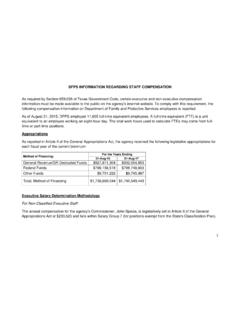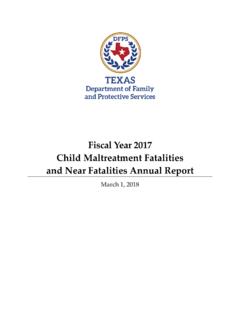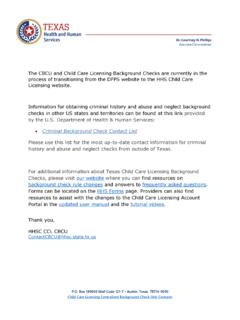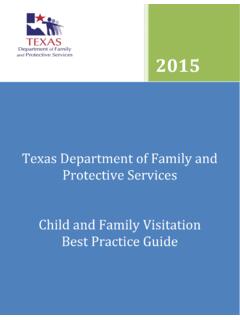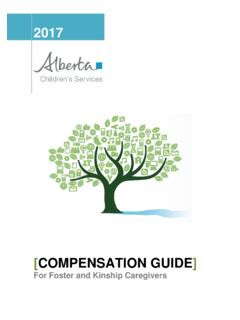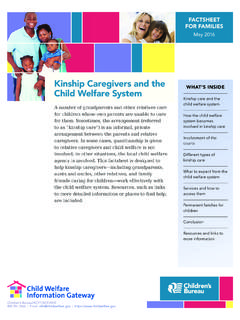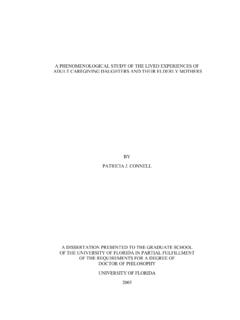Transcription of Placement Process Resource Guide - Texas Department of ...
1 I Placement Process Resource Guide Updated June 2022 i Table of Contents The Placement Process Overview .. 6 Definition of Placement .. 6 Initial Placement .. 7 Short-Term Emergency Placements .. 7 Subsequent Placements .. 7 Placement Types and Definitions .. 8 Own Home .. 8 Substitute Care .. 8 Regulated Foster Care .. 8 Types of Regulated caregivers .. 9 The Placement Process .. 10 Overview of Placement Process .. 10 Regional Placement Team .. 10 Definition of Regional Placement Team .. 10 State Office Requests .. 11 Requests to State Office Placement Division: .. 11 Placement Process for Children in Psychiatric or Medical Hospitals .. 13 Hospitalization Admission begins with Discharge Planning .. 13 Placement Process for Children with Intellectual and Developmental Disabilities Disability Specialist Referrals .. 14 DDS Placement Referral Process .. 14 CPS Caseworker Actions for Placement Change.
2 15 Per 4111 Identify the Need for Initial or Subsequent Placement : .. 15 Per Seek Regional Placement Team Assistance If Needed: .. 15 Gather Information and Recommendations to Select a Placement .. 15 Check IMPACT Records for Siblings .. 16 Consider Family Group Decision-Making (FGDM) .. 16 Consult the Biological Parent(s) .. 16 Consult the Child .. 17 Assessments in General .. 17 Issues to Consider in Placement Decisions .. 18 Issues to Consider .. 18 The Child's .. 19 The Parents' .. 19 The Caregiver's .. 20 Procedural Issues .. 21 Prompts .. 21 Preference for Non-Custodial Parents, Siblings, kinship , and Others with Significant Relationshipsi .. 21 Non-Custodial Parents .. 21 Considering a Non-Custodial Parent .. 22 Siblings .. 18 CPS Definition of Sibling .. 18 Separating Siblings .. 19 Placing Separated Siblings Back Together .. 19 Placement with Relatives and Fictive 19 Placement with Former Foster Parents.
3 20 Placement with Former Foster Parents Who Have Become Inactive .. 20 Placement with Adoptive Parents of Siblings .. 20 Evaluating Multiple Placement Options with Connections to the Child .. 21 Ensuring Education Stability .. 21 Placing the Child Close to the Child's Home .. 21 Specific Placement Considerations for Children Who have Primary Medical Needs .. 23 Definition of Primary Medical Needs(PMN) .. 23 Prohibited Considerations Based on Race, Color, National Origin or Ethnicity .. 23 Federal Law .. 23 State Law .. 23 CPS Policy .. 24 Get Approvals with the Required Timeframe Additional Regional Requirements .. 24 Actions Required after Selecting a Placement .. 24 Prepare the Child for the Move .. 24 Per 4122 Schedule and Conduct a Pre- Placement Visit: .. 24 Best Practice Tips to Support a Placement Move .. 24 Before the move: .. 25 At the time of the move: .. 26 After the move.
4 27 Discussion Topics for a Child Whose Placement is Changing .. 27 Appendices .. 27 Appendix 1: Working in IMPACT .. 27 Working in the Kin Stage in IMPACT .. 27 Appendix 2: Working in CLASS .. 31 Reviewing Variances in CLASS .. 31 Appendix 3: Roles and Responsibilities of the kinship Caregiver Worker .. 34 Tasks of the kinship Development Worker .. 35 Appendix 4: Questions for CPS Staff to Ask When Visiting in the Home with a Child with Primary i Medical Needs .. 41 Child Interview .. 41 Child Observation .. 42 Caregiver Interview .. 43 In-Home Provider and Staff Interview .. 44 Physical Walk-Through .. 45 Assessment of Child Safety and 45 iii Resource Guides The purpose of Resource Guides is to provide information that helps you do your job better. This information includes reference material, procedures, and guidelines that help you complete the tasks you are required to do by policy.
5 It's important to remember that the information in Resource Guides does not substitute for policy. We may sometimes include policy statements, but only to show you the policy to which the information is related. We will highlight any policy that actually appears in the Resource Guide and will almost always include a link to the actual policy. For example: The policy in the handbook always takes precedence over what is in the Resource Guide . We try to keep policy and Resource Guides synchronized, but sometimes there is a delay. If you have questions, always follow the policy in the Policy Handbook. Resource Guides provide important information on a range of topics, for the purpose of assisting and guiding staff to: make essential decisions develop strategies to address various issues perform essential procedures understand important processes identify and apply best practices The information in the Resource Guides is not policy (except where noted), and the actions and approaches described here are not mandates.
6 You should adapt the way you perform critical tasks to the individual needs and circumstances of the children and families with whom you work. State office and field staff are working together to identify Resource Guide topics, define the content, and develop the appropriate guides. CPS will regularly post Resource Guides as they are developed and update them as needed. Check the Resource Guides page, in the CPS Handbook, to see new or revised Guides. We hope these Guides provide useful information to Guide and assist CPS staff in effectively performing their job tasks. These Guides, combined with clear and concise policy in the Handbook, should help staff provide a high level of service to children in Texas . Per Re-Allowing Placement : If the caseworker learns of a detailed justification for changing the status of and considering placements in a foster family that is on Disallowed Placement status, the caseworker must elevate this consideration through the regional chain of command to the regional director.
7 June 2022 Placement Process Resource Guide The Placement Process Overview When a child is removed from his or her home, that child often experiences considerable grief and loss. Aside from being removed from his or her parents, the child no longer has access to his or her belongings, pets, friends, neighborhood relationships, or the familiarity of his or her surroundings. Also, regardless of the abuse, neglect, and/or trauma experienced, the child is being moved from his or her home and the people that she or he loves and cares about. If the child needs to be placed into foster care rather than with a non-custodial parent or kinship caregiver, the Placement experience is compounded because of the numerous changes the child will experience. When children move into foster care, more times than not the caregiver is a new person that the child did not previously know well, if at all.
8 The experience of moving into an unknown place with unknown people can be a difficulty transition. For all these reasons, it is important to never lose sight of how important it is to prepare a child for Placement while in foster care, to communicate with the child all along the way, and to ensure that the child remains connected to her or his family and other connections throughout his or her time in care. This Resource Guide will provide guidance, recommendations, and procedures regarding the Placement Process and the important things to consider when making this very important decision. Definition of Placement When CPS is named temporary or permanent managing conservator of a child or youth, CPS staff become responsible for selecting a Placement which keeps the child safe, supports the child s permanency plan, and best meets the child s needs. Placements take a variety of forms, such as Placement with a non-custodial parent or a reliance on relatives as caregivers , which is a practice with a strong historical precedent across many cultures.
9 kinship and fictive kin placements are time-honored traditions that allow children to maintain their important connections to family, community, and culture. Whenever possible, CPS emphasizes placements with non-custodial parents, kin, and other significant connections. When a Placement with a non-custodial parent or kinship Placement is not feasible, for whatever reason, the alternative is regulated foster care. Regardless of the Placement type, many factors influence the decision on where a child should be placed. Before determining the best available Placement , the caseworker and supervisor consider a host of factors, including: the child's safety; the child s preferences and needs; the family s preferences; the permanency goal; educational stability; and Placement with siblings. June 2022 Placement Process Resource Guide The same factors which apply in making an initial Placement will also hold true when a subsequent Placement is necessary.
10 Initial Placement Whenever a child first enters conservatorship, the goal is to identify a Placement that meets all of the child's needs and will be the last Placement prior to the child achieving positive permanency. However, there might be times that the initial Placement is a short-term emergency Placement . Short-Term Emergency Placements Many initial placements are made on an emergency basis, either when: a child is removed from home and Placement is needed immediately; or a child s current Placement is disrupted, and it is not possible to immediately find another caregiver. If a child is placed initially in a short-term emergency Placement , staff must immediately begin efforts to locate another Placement . This is important because once a child, youth, or sibling group has stayed in a particular Placement for a while, it becomes more difficult to transfer to a different Placement .
